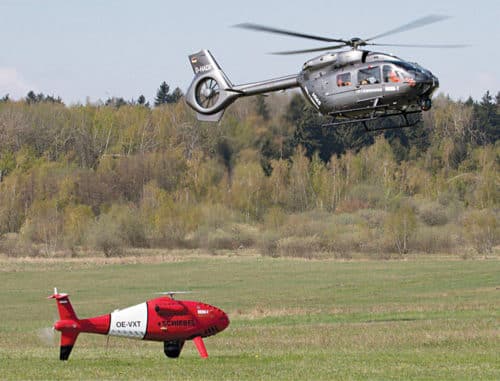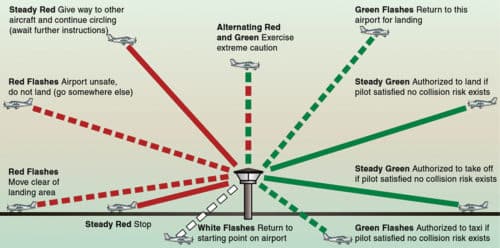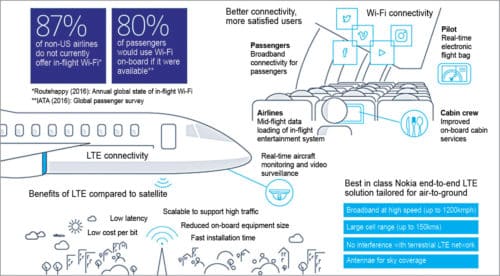This article discusses some key recent developments in the area of wireless networking in the aviation industry.
New techniques and technologies in wireless communication are needed for safe and efficient aviation operations. To keep track of airplanes, pilots use high-frequency radio signals to communicate with ground controllers and other aircraft. The aircraft in low-altitude airspace plays a key role in this network, for prospects such as emergency communication, routing patrol and wireless data relay.
A unique application of wireless technology came into focus when Airbus H145 manned helicopter and Schiebel Camcopter S-100 unmanned aerial vehicle (UAV) demonstrated the highest level of Manned Unmanned Teaming (MUM-T) capabilities. The manned helicopter had full control over the UAV, including its take off, landing, payload, launch, recovery and transmission of sensor data obtained by the latter.

A smaller unmanned aerial system (UAS) having vertical take-off and landing capabilities can fly closer around obstacles, such as trees or buildings, to detect hidden objects in places not accessible by traditional helicopters. It can explore unknown territory and deliver information to the helicopter crew, which is operating from a safe position and which can then step in with the helicopter’s superior effects, having received a clear picture from the UAS.
This wireless technology advancement is highly valuable and mission enhancing for army aviation in complex operations and dangerous environments. MUM-T leverages the strengths of both manned and unmanned systems by providing pilots of manned aircraft with the ability to take full advantage of the intelligence, surveillance and reconnaissance (ISR) capabilities of the UAS and, thereby, significantly improving safety and decision-making capability in complex missions. This approach of enhancing coverage and timeliness of information, while keeping pilots and manned assets safe, enables commanders to maximise the advantages offered by both the platforms.
Role of wireless technology in aviation
Wireless technologies and networks are playing an important role in aviation at a growing pace. Commercial adoption and technological advancements are pushing the entire industry forward. Every aspect from core technology to the fundamentals of certification and safety are under consideration. National Aeronautics and Space Administration (NASA) is working to improve hyper-spectral communications, networking and air traffic control for efficient and safe future flights.
Earle Olson, vice president, Airborne Wireless Network, says, “Wireless communication for aviation, traditionally, has been relegated to weather and flight information. Beyond this, there have been additional applications related to in-flight entertainment. This area has been supported by ground-to-air and sat-com applications as well as wireless access points onboard aircraft.”
He adds, “Airborne Wireless Network is developing a high-performance communications system to provide a wholesale airborne wireless broadband service to provide service on a global basis, utilising commercial aircraft as part of its global airborne mesh network. This is a path-breaking technology that has the potential to augment connectivity to the underserved regions of the world and improve connectivity for all. By virtue of the system being onboard commercial aircraft, its system could also support in-flight entertainment companies with a provision and drastically improve the Wi-Fi provider’s service quality and overall passenger experience.”

In aircraft, various parts are designed just to keep track of its location and broadcast it. The black box, fitted with an underwater locator, records flight data and communications within the cockpit. GPS allows pilots to navigate and determine where they are.
Transponders transmit signals to be picked up by radars. Aircraft communications addressing and reporting system allows pilots to send short text messages transmitted through radio signals and satellites to ground control.
There are two types of radars: primary and secondary. Primary radars monitor flight location by sending out radio waves that bounce off aircraft (usually used by the military). Secondary radars send out radio signals that transponders automatically send back to identify planes (usually used by civil air traffic control). An aircraft determines its position via satellite navigation and periodically broadcasts it using automatic dependent surveillance broadcast (ADS-B)—a surveillance technology—enabling it to be tracked and used by flight tracking websites or apps.
Mobile networks and air communication join at Airline Communication Proxy (ACP). To provide services from SMSes up to full voice services, ACP is equipped in a modular way and is available for Windows, Mac and Linux platforms. ACP can control an entire fleet of operational aircraft, flying or at airports.
Challenges with wireless technology for aviation
Providing fast, robust and reliable wireless connectivity in aircraft is a challenge. For airline operators, delay and congestion pose a serious problem. Delay of a single flight can affect several other flights passing by. Reducing time by just ten minutes with an average trip length of 500 nautical miles improves aircraft efficiency by eight per cent. Critical radio frequency management and wireless infrastructure planning is required to understand capacity and demand issues arising from UAVs.
Most communication between ground and aircraft are done using satellites. This slows data speed among passengers of multiple aircraft, due to sharing capacity and relatively wider coverage. This leads to an increase in demand to improve communication quality for onboard passengers.
Latest wireless technologies for aviation
Approximately 80 per cent passengers would use Wi-Fi onboard if it were available. This provides better connectivity and, hence, more satisfaction among users. Some other features include real-time electronic flight bags, improved onboard cabin services, mid-flight data loading of in-flight entertainment systems and real-time aircraft monitoring and video surveillance.
A recent technology, called system wide information management (SWIM), provides efficient and safe information sharing in civil aviation. It provides efficient integration of the current air traffic monitoring systems and enables these to achieve seamless services worldwide.
Aeronautical mobile airport communications system (AeroMACS) provides a 5GHz ground-to-air communication link for high-speed movement scenarios. AeroMACS is effective in sharing various information types on airport surface, in taking off and landing among pilots, airport operators and air traffic controllers. It is generally used at a speed of 120kmph or below.
Navigation Research Institute scientists conducted flight tests using an AeroMACS standard-compliant prototype system and an experimental aircraft. Result shows that multiple input multiple output (MIMO) operation is achievable by an onboard antenna configuration with vertical placement at the top and bottom of the aircraft body. Other throughput measurements revealed that it was possible to access SWIM both in takeoff and landing situations at an aircraft speed of 200kmph.
f.u.n.k.e. AVIONICS has been cooperating with Airbus and other partners to develop wireless sensor/actuator networks (WSNs) for commercial aircraft. WSNs provide advantages like flexibility, weight reduction and cost reduction in aircraft manufacturing. Safety and reliability requires technologies and solutions adapted to onboard aircraft applications. One key element is the use of a dedicated, aviation-exclusive radio frequency band that precludes interference with commercial wireless systems such as WLAN or Bluetooth.
With the popularity of UAVs and general aviation, the concept of integrated space communications networks provides various reliable methods in aviation communication and surveillance. Low-altitude air-to-ground communication has two specialties, which are significant for the reliability of wireless communication. One is dynamic and moving nodes, like drones in the sky and automobiles on highway. High-motion transreceivers suffer from fast fading and frequency shift. The second is a changing scenario. For example, high-motion nodes on ground, such as high-speed rail, could quickly depart countryside and enter urban areas. Communication near the boundary changes and fluctuates rapidly, worsening the quality of communication.

Air traffic control is the backbone of the traffic load, which continues to grow dramatically every year. In the near future, we can expect a major boost in air traffic, with the growing use of UAVs for civil applications. Industry forecasts predict that worldwide flight movements will double by 2030.










